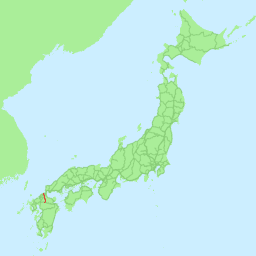|
Tagawa-Gotōji Station
is a railway station in Tagawa, Fukuoka, Japan, operated by Kyushu Railway Company (JR Kyushu) and Heisei Chikuho Railway. Lines Tagawa-Gotōji Station is served by the Hitahikosan Line, Gotōji Line and Heisei Chikuho Railway Itoda Line. Adjacent stations See also * List of railway stations in Japan The links below contain all of the 8579 railway stations in Japan. External links {{Portal bar, Japan, Trains * Railway stations Japan Japan ( ja, 日本, or , and formally , ''Nihonkoku'') is an island country in East Asia. ... References External links * Railway stations in Japan opened in 1896 Railway stations in Fukuoka Prefecture Tagawa, Fukuoka {{Fukuoka-railstation-stub ... [...More Info...] [...Related Items...] OR: [Wikipedia] [Google] [Baidu] |
Tagawa, Fukuoka
is a city located in Fukuoka Prefecture, Japan. The city was founded on November 3, 1943. As of October 1, 2018, the city has an estimated population of 48,241, with 24,537 households. Its total area is 54.52 km². Tagawa was historically a coal mining city, and is easily recognizable by its two tall chimneys located near Tagawa-Ita (田川伊田駅). Currently active industries in Tagawa include limestone and cement production. Tirol (チロル) miniature chocolates are manufactured in Tagawa. The TRIAL Kyushu warehouse is located in Ita-machi, and services TRIAL discount stores in all prefectures in Kyushu. Tagawa is serviced by two main JR stations, Tagawa-Ita (田川伊田) and Tagawa-Gotōji (田川後藤寺). These stations provide transport links to Kokura, Hita, and Shin-Iizuka via the Hitahikosan Line (日田彦山線) and Gotōji Line (後藤寺線). In addition, the private rail company Heisei Chikuho Railway Line (terminal points: Yukuhashi and Nōgata ... [...More Info...] [...Related Items...] OR: [Wikipedia] [Google] [Baidu] |
Fukuoka Prefecture
is a Prefectures of Japan, prefecture of Japan located on the island of Kyūshū. Fukuoka Prefecture has a population of 5,109,323 (1 June 2019) and has a geographic area of 4,986 Square kilometre, km2 (1,925 sq mi). Fukuoka Prefecture borders Saga Prefecture to the southwest, Kumamoto Prefecture to the south, and Ōita Prefecture to the southeast. Fukuoka is the capital and largest city of Fukuoka Prefecture, and the largest city on Kyūshū, with other major cities including Kitakyushu, Kurume, and Ōmuta, Fukuoka, Ōmuta. Fukuoka Prefecture is located at the northernmost point of Kyūshū on the Kanmon Straits, connecting the Tsushima Strait and Seto Inland Sea across from Yamaguchi Prefecture on the island of Honshu, and extends south towards the Ariake Sea. History Fukuoka Prefecture includes the Old provinces of Japan, former provinces of Chikugo Province, Chikugo, Chikuzen Province, Chikuzen, and Buzen Province, Buzen. Shrines and temples Kōra taisha, Sumiyoshi-jinja, ... [...More Info...] [...Related Items...] OR: [Wikipedia] [Google] [Baidu] |
Heisei Chikuhō Railway Logo
The is the period of Japanese history corresponding to the reign of Emperor Emeritus Akihito from 8 January 1989 until his abdication on 30 April 2019. The Heisei era started on 8 January 1989, the day after the death of the Emperor Hirohito, when his son, Akihito, acceded to the throne as the 125th Emperor. In accordance with Japanese customs, Hirohito was posthumously renamed "Emperor Shōwa" on 31 January 1989. Thus, 1989 corresponds to Shōwa 64 until 7 January, and from 8 January. The Heisei era ended on 30 April 2019 (Heisei 31), with the abdication of Akihito from the Chrysanthemum Throne. It was succeeded by the Reiwa era as then-crown prince Naruhito ascended the throne on 1 May midnight local time. History and meaning On 7 January 1989, at 07:55 AM JST, the Grand Steward of Japan's Imperial Household Agency, Shōichi Fujimori, announced Emperor Hirohito's death at 6:33 AM JST, and revealed details about his cancer for the first time. Shortly after the d ... [...More Info...] [...Related Items...] OR: [Wikipedia] [Google] [Baidu] |
Heisei Chikuho Railway
The is the period of Japanese history corresponding to the reign of Emperor Emeritus Akihito from 8 January 1989 until his abdication on 30 April 2019. The Heisei era started on 8 January 1989, the day after the death of the Emperor Hirohito, when his son, Akihito, acceded to the throne as the 125th Emperor. In accordance with Japanese customs, Hirohito was posthumously renamed "Emperor Shōwa" on 31 January 1989. Thus, 1989 corresponds to Shōwa 64 until 7 January, and from 8 January. The Heisei era ended on 30 April 2019 (Heisei 31), with the abdication of Akihito from the Chrysanthemum Throne. It was succeeded by the Reiwa era as then-crown prince Naruhito ascended the throne on 1 May midnight local time. History and meaning On 7 January 1989, at 07:55 AM JST, the Grand Steward of Japan's Imperial Household Agency, Shōichi Fujimori, announced Emperor Hirohito's death at 6:33 AM JST, and revealed details about his cancer for the first time. Shortly after the deat ... [...More Info...] [...Related Items...] OR: [Wikipedia] [Google] [Baidu] |
Itoda Line
The is a 6.8 km railway line owned by the Heisei Chikuhō Railway. The line runs north from Tagawa to Kanada Station, all within Fukuoka Prefecture. History The Itoda Line was built in two parts. The first part was built in 1897 as a branch line by the , a third-sector railway to transport coal from the Chikuhō Coal Mine. It ran north from Gotōji Station (now Tagawa-Gotōji Station) to Miyatoko Station (now Itoda Station). Hōshū Railway was acquired by Kyushu Railway in 1901, which was then nationalized in 1907 into Japanese Government Railways (JGR) under the Railway Nationalization Act. After being nationalized, the line was known as the . In 1927, another third-sector railway company, , built the section between Miyatoko and Kanada Station. Within the same year, the line was transferred to the , who then changed their name to in 1933. The line was sold in 1943 during the Second World War to JGR, who operated the entire line as the Itoda Line. With the privatizat ... [...More Info...] [...Related Items...] OR: [Wikipedia] [Google] [Baidu] |
Kyushu Railway Company
The , also referred to as , is one of the seven constituent companies of Japan Railways Group (JR Group). It operates intercity rail services within Kyushu, Japan and the JR Kyushu Jet Ferry Beetle hydrofoil service across the Tsushima Strait between Fukuoka and Busan, South Korea. It also operates hotels, restaurants, and drugstores across its service region. JR Kyushu's headquarters are in Hakata-ku, Fukuoka. ." Kyushu Railway Company. Retrieved on March 27, 2010. History When was divided in 1987, Kyushu Railway Company inherited its assets and operations on the island of |
Hitahikosan Line
The is a railway line in Japan, operated by Kyushu Railway Company (JR Kyushu). It connects Jōno Station in Kitakyushu, Fukuoka Prefecture with Yoake Station in Hita, Ōita Prefecture and features the 4380 m Shakadake Tunnel between Chikuzen Iwaya and Hikosan station, where a fatal tunnel collapse occurred during construction in 1953, killing 21 construction workers. The line is named after Hita and Mount Hiko. Stations :●: Stops, |: non-stop History The Toyo-shu Railway Co. opened the Tagawa-Ita - Buzen Kawasaki section as part of the Tagawa Line in 1899. That company merged with the Kyushu Railway Company in 1901, which extended the line to Soeda in 1903. The company was nationalised in 1907. The Jono - Tagawa-Ita section was opened in 1915 by the Kokura Railway Co., that company being nationalised in 1943. The Soeda - Daigyoji section opened between 1937 and 1946, and the Daigyoji - Yoake section opened in 1956. CTC signalling was introduced on the entire line in 1 ... [...More Info...] [...Related Items...] OR: [Wikipedia] [Google] [Baidu] |
Gotōji Line
The is a Japanese railway line in Fukuoka Prefecture connecting Tagawa-Gotōji Station in the city of Tagawa and Shin-Iizuka Station in the city of Iizuka. It is part of the JR Kyushu network. Basic data *Operator, distances: **Kyushu Railway Company (JR Kyushu) (Services and tracks) ***Tagawa-Gotōji – Shin-Iizuka: *Gauge: Narrow gauge, *Stations: 6 *Double-tracking: None *Electrification: None *Railway signalling: Special automatic Station list * All stations are located in Fukuoka Prefecture. * Rapid trains, which only operate in the direction of Tagawa-Gotōji, stop at stations marked "●" and pass stations marked "↑". History The Hōshū Railway Co. opened the central section of the line in 1897 to haul freight, the company merging with the Kyushu Railway was a company that built and operated railways in Kyushu, one of four main islands of Japan. Most of its lines came under the control of Japanese Government Railways following nationalization in 1907, a ... [...More Info...] [...Related Items...] OR: [Wikipedia] [Google] [Baidu] |
List Of Railway Stations In Japan ...
The links below contain all of the 8579 railway stations in Japan. External links {{Portal bar, Japan, Trains * Railway stations Japan Japan ( ja, 日本, or , and formally , ''Nihonkoku'') is an island country in East Asia. It is situated in the northwest Pacific Ocean, and is bordered on the west by the Sea of Japan, while extending from the Sea of Okhotsk in the north ... [...More Info...] [...Related Items...] OR: [Wikipedia] [Google] [Baidu] |
Railway Stations In Japan Opened In 1896
Rail transport (also known as train transport) is a means of transport that transfers passengers and goods on wheeled vehicles running on rails, which are incorporated in tracks. In contrast to road transport, where the vehicles run on a prepared flat surface, rail vehicles (rolling stock) are directionally guided by the tracks on which they run. Tracks usually consist of steel rails, installed on sleepers (ties) set in ballast, on which the rolling stock, usually fitted with metal wheels, moves. Other variations are also possible, such as "slab track", in which the rails are fastened to a concrete foundation resting on a prepared subsurface. Rolling stock in a rail transport system generally encounters lower frictional resistance than rubber-tyred road vehicles, so passenger and freight cars (carriages and wagons) can be coupled into longer trains. The operation is carried out by a railway company, providing transport between train stations or freight customer faciliti ... [...More Info...] [...Related Items...] OR: [Wikipedia] [Google] [Baidu] |
Railway Stations In Fukuoka Prefecture
Rail transport (also known as train transport) is a means of transport that transfers passengers and goods on wheeled vehicles running on rails, which are incorporated in tracks. In contrast to road transport, where the vehicles run on a prepared flat surface, rail vehicles (rolling stock) are directionally guided by the tracks on which they run. Tracks usually consist of steel rails, installed on sleepers (ties) set in ballast, on which the rolling stock, usually fitted with metal wheels, moves. Other variations are also possible, such as "slab track", in which the rails are fastened to a concrete foundation resting on a prepared subsurface. Rolling stock in a rail transport system generally encounters lower frictional resistance than rubber-tyred road vehicles, so passenger and freight cars (carriages and wagons) can be coupled into longer trains. The operation is carried out by a railway company, providing transport between train stations or freight customer faciliti ... [...More Info...] [...Related Items...] OR: [Wikipedia] [Google] [Baidu] |


b.jpg)



